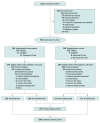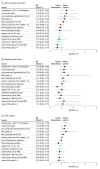Ventilatory Assistance Before Umbilical Cord Clamping in Extremely Preterm Infants: A Randomized Clinical Trial
- PMID: 38758557
- PMCID: PMC11102017
- DOI: 10.1001/jamanetworkopen.2024.11140
Ventilatory Assistance Before Umbilical Cord Clamping in Extremely Preterm Infants: A Randomized Clinical Trial
Abstract
Importance: Providing assisted ventilation during delayed umbilical cord clamping may improve outcomes for extremely preterm infants.
Objective: To determine whether assisted ventilation in extremely preterm infants (23 0/7 to 28 6/7 weeks' gestational age [GA]) followed by cord clamping reduces intraventricular hemorrhage (IVH) or early death.
Design, setting, and participants: This phase 3, 1:1, parallel-stratified randomized clinical trial conducted at 12 perinatal centers across the US and Canada from September 2, 2016, through February 21, 2023, assessed IVH and early death outcomes of extremely preterm infants randomized to receive 120 seconds of assisted ventilation followed by cord clamping vs delayed cord clamping for 30 to 60 seconds with ventilatory assistance afterward. Two analysis cohorts, not breathing well and breathing well, were specified a priori based on assessment of breathing 30 seconds after birth.
Intervention: After birth, all infants received stimulation and suctioning if needed. From 30 to 120 seconds, infants randomized to the intervention received continuous positive airway pressure if breathing well or positive-pressure ventilation if not, with cord clamping at 120 seconds. Control infants received 30 to 60 seconds of delayed cord clamping followed by standard resuscitation.
Main outcomes and measures: The primary outcome was any grade IVH on head ultrasonography or death before day 7. Interpretation by site radiologists was confirmed by independent radiologists, all masked to study group. To estimate the association between study group and outcome, data were analyzed using the stratified Cochran-Mantel-Haenszel test for relative risk (RR), with associations summarized by point estimates and 95% CIs.
Results: Of 1110 women who consented to participate, 548 were randomized and delivered infants at GA less than 29 weeks. A total of 570 eligible infants were enrolled (median [IQR] GA, 26.6 [24.9-27.7] weeks; 297 male [52.1%]). Intraventricular hemorrhage or death occurred in 34.9% (97 of 278) of infants in the intervention group and 32.5% (95 of 292) in the control group (adjusted RR, 1.02; 95% CI, 0.81-1.27). In the prespecified not-breathing-well cohort (47.5% [271 of 570]; median [IQR] GA, 26.0 [24.7-27.4] weeks; 152 male [56.1%]), IVH or death occurred in 38.7% (58 of 150) of infants in the intervention group and 43.0% (52 of 121) in the control group (RR, 0.91; 95% CI, 0.68-1.21). There was no evidence of differences in death, severe brain injury, or major morbidities between the intervention and control groups in either breathing cohort.
Conclusions and relevance: This study did not show that providing assisted ventilation before cord clamping in extremely preterm infants reduces IVH or early death. Additional study around the feasibility, safety, and efficacy of assisted ventilation before cord clamping may provide additional insight.
Trial registration: ClinicalTrials.gov Identifier: NCT02742454.
Conflict of interest statement
Figures


References
Publication types
MeSH terms
Associated data
Grants and funding
LinkOut - more resources
Full Text Sources
Medical

